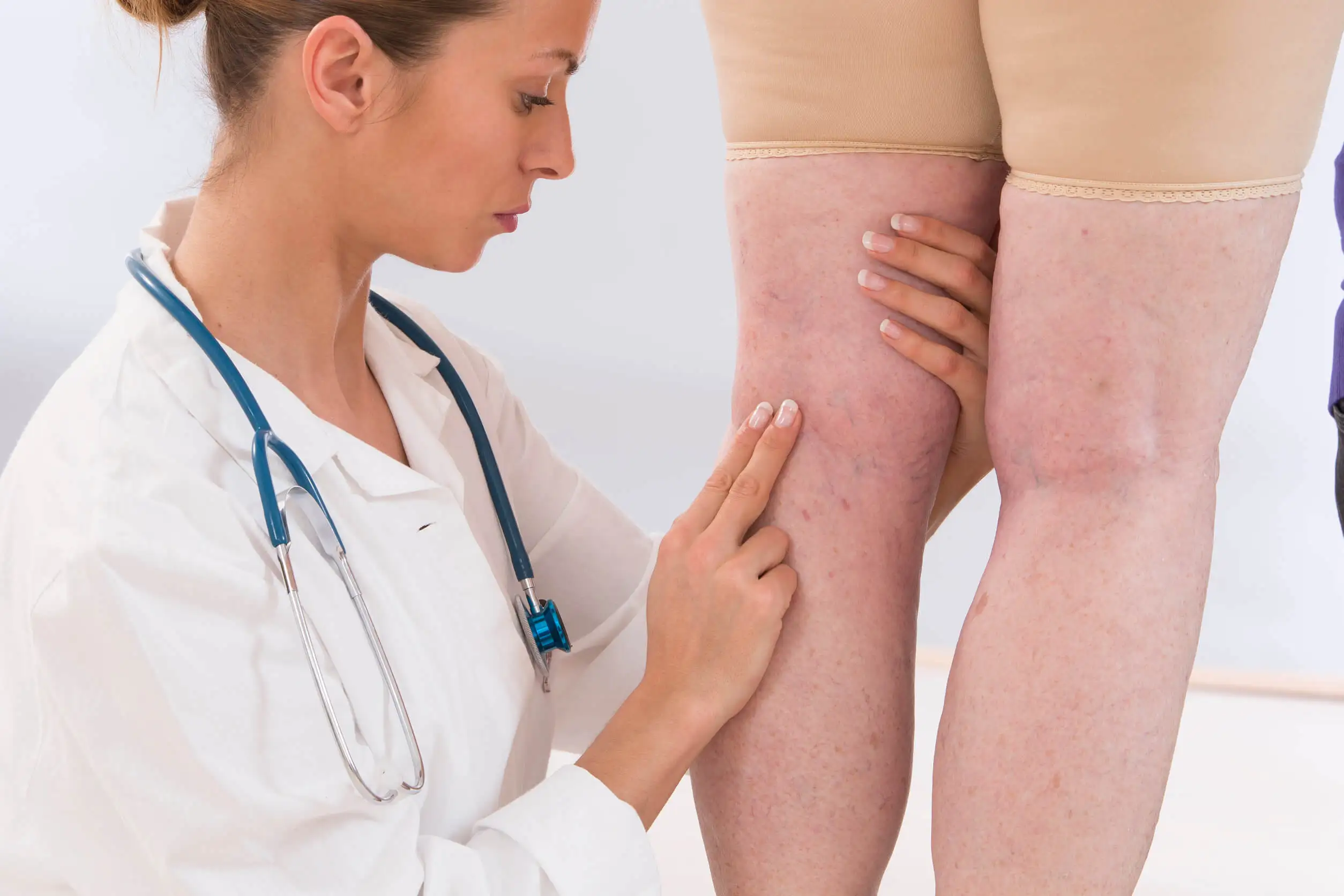Sclerotherapy for Varicose Veins: How is it Performed?


Reviewed and approved by the nurse Leidy Mora Molina
Sclerotherapy of varicose veins is a procedure performed by injecting an irritating foam into the affected blood vessels. It has the function of helping to heal and fade them. In this way, it allows to minimize or eliminate these so-called “spider veins“.
This is considered a simple, effective, and quick treatment with a fast recovery. Results can be noticed in a few weeks, although sometimes it takes longer or several sessions are required. In any case, it’s not exempt from causing some side effects. What are they? In the following article, we’re going to tell you all of the details.
What is sclerotherapy of varicose veins and why is it done?
Varicose veins are bulging veins that are usually located mainly in the legs. However, they can also appear in other areas of the body, such as the vulva. The causes of their appearance are related to circulation problems.
Apart from representing an aesthetic problem, they cause symptoms such as the following:
- Itching
- Pain
- Hot sensation
- Heaviness and swelling in the extremities
- When complicated, they can cause phlebitis, clots, hemorrhages, and ulcers
However, there are different alternatives for their treatment, ranging from the use of compression stockings and physical activity, as well as changes in diet, to laser treatments and radiofrequency ablation.
In this order of ideas, a procedure widely used today is sclerotherapy of varicose veins. In this procedure, a sclerosing foam is injected to promote the healing of the blood vessels so that they close.
In particular, this technique can be used to treat small varicose veins that don’t cause major problems. It can even be applied to those that reappear after varicose vein stripping surgery or as an adjunct to such a surgical procedure.
Although it’s usually done for cosmetic purposes, it can also help improve some related symptoms, including swelling, burning, pain, and cramping.

We think you may be interested in reading this, too: Endolaser Surgery for Varicose Veins: What Is It and What Are Its Benefits?
How is sclerotherapy of varicose veins performed?
Although this is a relatively simple treatment that does not require hospitalization, for sclerotherapy of varicose veins, there must be a previous preparation, as well as some aftercare. Below, we will learn about the entire process.
Previous preparation
Before the procedure, the physician must perform a physical examination to take a particular look at the veins to be treated. It is also necessary to know if there are any underlying pathologies of the blood vessels, varicose vein treatments that the person has undergone previously, as well as their results.
The following is taken into consideration in the medical history:
- A history of heart disease.
- A history of allergy.
- Pharmacological treatments (especially the consumption of anticoagulants).
- Consumption of supplements (especially iron).
Among the tests performed are ultrasound imaging studies, as well as ultrasound, to know the state of the veins.
Other recommendations include not shaving the day before, avoiding applying lotions or other products, and wearing loose clothing. It’s even best to wear shorts to avoid rubbing the legs.
Like this article? You may also like to read: Important! Guidelines to Reduce the Discomfort of Varicose Veins in the Summer
What is the procedure like?
Sclerotherapy of varicose veins can be done on an outpatient basis in the doctor’s office or in a clinic but does not require hospitalization.
It is not very painful. No anesthesia is needed unless there is tenderness. However, there are some sclerosing solutions that contain lidocaine.
The procedure follows these steps:
- The person must remain lying down.
- The leg to be treated is elevated.
- The area should be disinfected with alcohol.
- The sclerosing solution is injected into the varicose vein with a fine needle.
- Pressure is then applied to prevent the blood from flowing back when the person stands up. A pad may also be placed for this purpose.
The number of injections, as well as the total duration, depends on the number and size of the veins. On average, the procedure takes less than an hour.
Aftercare
Once the injections are completed, you should get up and walk around a bit to prevent clots from forming. You may then return to your normal activities the same day (though preferably not driving).
Other suggestions include the following:
- Do not apply lotion to the legs, especially if it contains alcohol.
- Wear compression stockings for a few days; in some cases, up to 15 days.
- Avoid exercise for the first few weeks after the procedure; then you can begin, but in moderation.
- Do not expose your legs to the sun during the recovery period to avoid the appearance of spots.
It’s recoommended to see your doctor one month after the procedure to evaluate the results and determine if more sessions are required. However, for the latter, it’s advisable to wait a couple of weeks more.
The results and benefits
The solution that is injected blocks the blood flow, which causes the treated veins to turn into scar tissue and then disappear. Final results may take three to six weeks, although larger veins may disappear in four months. In some cases, more sessions are needed.
In general, the treated veins usually respond to the treatment and do not return; although it is possible that other varicose veins may develop that were not there before, depending on factors associated with the person’s lifestyle and predisposition.
Another advantage of this treatment is that it’s minimally invasive. Plus, since it does not require hospitalization, recovery is faster, as well as the return to activities. In addition, it’s less expensive compared to surgery.
As for effectiveness, a meta-analysis shows that positive results are observed in approximately 78% of cases. It can even help to reduce some symptoms and improve the appearance of the surrounding skin. However, more than 20% of people may not notice improvement.
A review of studies details that sclerotherapy has not been sufficiently compared with other interventions or treatments for varicose veins. Therefore, there is not complete certainty about its safety and efficacy. Further research is needed.

The possible risks and side effects
Injection of the sclerosing solution may be painful for some people and may cause a stinging or cramping sensation. There are also other temporary side effects, such as:
- Redness and bruising in the area
- Bruising or small sores
- Darkened skin or spots
- Lumps or swelling
- Red vessels
- Blood clots
- Allergic reaction
Such effects should disappear after a short time; but if they persist, a visit to the physician is required to determine a treatment, which may include analgesics, anti-inflammatory drugs, antihistamines, and drainage.
As for complications, the risk of infection is not ruled out. It may also be that a clot travels into a vein; if so, there is a risk of deep vein thrombosis. In any case, it is rare.
Other possible complications are the appearance of ulcers or death of the surrounding tissue (skin necrosis). The latter can happen if the sclerosing fluid leaks out of a vein, due to malpractice or when the vein wall is weakened.
When is sclerotherapy contraindicated? sclerotherapy?
Sclerotherapy of varicose veins is a treatment that should not be practiced in certain cases. For example, if the woman is pregnant or breastfeeding. This is because it’s not known if it causes abnormalities in the fetus or damage to the nursing baby.
It’s also not recommended for people who are allergic to sclerosants, suffer from clots, or have a history of thrombosis. In any case, it should be discussed with the physician to evaluate other treatment options.
All cited sources were thoroughly reviewed by our team to ensure their quality, reliability, currency, and validity. The bibliography of this article was considered reliable and of academic or scientific accuracy.
- Van den Bos R, et al. Endovenous therapies of lower extremity varicosities: A meta-analysis. Journal of Vascular Surgery. 2009; 49(1): 230–239.
- De Ávila Oliveira R, Riera R, Vasconcelos V, Baptista-Silva JC. Injection sclerotherapy for varicose veins. Cochrane Database Syst Rev. 2021;12(12): doi 10.1002/14651858.CD001732.pub3.
- Álvez M, Cabillón J. Ablación endovenosa por radiofrecuencia para el tratamiento de las várices. Salud Mil. 2020; 39(2): 38-7. Disponible en: https://revistasaludmilitar.uy/ojs/index.php/Rsm/article/view/108
- Vaquero Puerta C, Del Río L, de Marino P. Tratamiento quirúrgico de las varices. Anales de la Real Academia de Medicina y Cirugía de Valladolid. 2015; 52: 33-46.
- Ahumada M, Vioque J. Prevalencia de varices en adultos y factores asociados. Medicina Clínica. 2004; 123(17): 647-651
- Weinmann E, Salzman E. Trombosis venosa profunda. Rev cubana med. 1996; 35(2): 118-135.
- E. Rabe, Et al., (2020). Sclerotherapy in the treatment of varicose veins. S2k guideline of the Deutsche Gesellschaft für Phlebologie (DGP)… Disponible en: https://link.springer.com/article/10.1007/s00105-020-04705-0
- Oliveria A, Et al., (2021). Tratamiento con escleroterapia para las varices. Disponible en: https://www.cochrane.org/es/CD001732/PVD_tratamiento-con-escleroterapia-para-las-varices
This text is provided for informational purposes only and does not replace consultation with a professional. If in doubt, consult your specialist.








